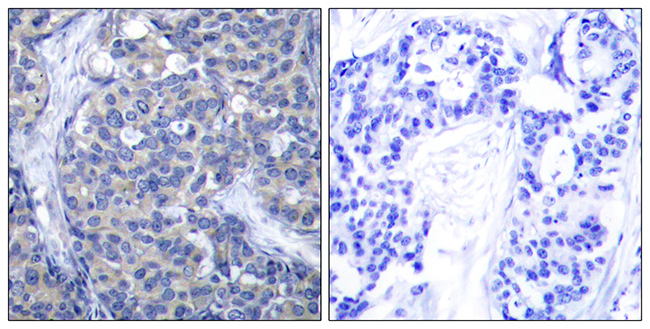
Immunohistochemical staining of formalin fixed and paraffin embedded human tonsil tissue section using Anti-MPO Rabbit Monoclonal Antibody (Clone RM407) at a 1:100 dilution.
anti-ZAP70 (human), Rabbit Monoclonal (RM408)
REV-31-1294-00
ApplicationsWestern Blot, ImmunoHistoChemistry
Product group Antibodies
ReactivityHuman
TargetZAP70
Overview
- SupplierRevMAb Biosciences
- Product Nameanti-ZAP70 (human), Rabbit Monoclonal (RM408)
- Delivery Days Customer10
- ApplicationsWestern Blot, ImmunoHistoChemistry
- CertificationResearch Use Only
- ClonalityMonoclonal
- Clone IDRM408
- Gene ID7535
- Target nameZAP70
- Target descriptionzeta chain of T cell receptor associated protein kinase 70
- Target synonymsADMIO2, IMD48, SRK, STCD, STD, TZK, ZAP-70, tyrosine-protein kinase ZAP-70, 70 kDa zeta-associated protein, 70 kDa zeta-chain associated protein, syk-related tyrosine kinase, zeta chain of T cell receptor associated protein kinase 70kDa, zeta-chain (TCR) associated protein kinase 70kDa, zeta-chain associated protein kinase, 70kD
- HostRabbit
- IsotypeIgG
- Protein IDP43403
- Protein NameTyrosine-protein kinase ZAP-70
- Scientific DescriptionRecombinant Antibody. This antibody reacts to human ZAP70. Applications: WB, IHC. Source: Rabbit. Liquid. 50% Glycerol/PBS with 1% BSA and 0.09% sodium azide. ZAP70 is a member of the Syk tyrosine kinase family and plays a central role in lymphocyte activation and development, and is implicated in several immune disorders. Upon T cell antigen receptor (TCR) engagement, ZAP70 is phosphorylated on tyrosines 292, 315 and 319 in the interdomain B, located between the SH2 and kinase domains. Phosphorylation of both tyrosines 315 (a Vav binding site) and 319 (a Lck binding site) enhances ZAP70 function in mediating lymphocyte signaling, while tyrosine 292 terminates the transient activation of ZAP70 and attentuates lymphocyte signaling. ZAP-70 in B cells is used as a prognostic marker in identifying different forms of chronic lymphocytic leukemia (CLL). In systemic lupus erythematosus, the Zap-70 receptor pathway is missing and Syk takes its place. - ZAP70 is a member of the Syk tyrosine kinase family and plays a central role in lymphocyte activation and development, and is implicated in several immune disorders. Upon T cell antigen receptor (TCR) engagement, ZAP70 is phosphorylated on tyrosines 292, 315 and 319 in the interdomain B, located between the SH2 and kinase domains. Phosphorylation of both tyrosines 315 (a Vav binding site) and 319 (a Lck binding site) enhances ZAP70 function in mediating lymphocyte signaling, while tyrosine 292 terminates the transient activation of ZAP70 and attentuates lymphocyte signaling. ZAP-70 in B cells is used as a prognostic marker in identifying different forms of chronic lymphocytic leukemia (CLL). In systemic lupus erythematosus, the Zap-70 receptor pathway is missing and Syk takes its place.
- ReactivityHuman
- Storage Instruction-20°C
- UNSPSC12352203





